Meredith R. Stoddard's Blog, page 18
February 14, 2012
A Valentine for my Valentine
It doesn't sound terribly romantic, but as I was watching my husband hold back our 5-year-old daughter's hair while she emptied the meager contents of her stomach this morning I was taken back fifteen years to the day to our first date. That's right. Our first date was on Valentine's Day (no pressure, right?). I think most couple would not want top start their relationships on Valentine's Day, but for us it wouldn't have mattered, because I think we knew right from the beginning that this is where we would be. We just sort of fell in to each other's rhythms and never really looked back.
Now, nobody is perfect and I'm not saying it's all been smooth sailing. But no matter what the issue we usually work our way around to the same page and haven't gotten bored with each other. When eit[image error]her one of us needs to hear a voice of reason, the other is there. When my inner hermit is winning and I just want to shut myself away, he draws me out into the world. Now, with two ridiculously smart kids who surprise us almost daily with their views of the world life is always an adventure with the Stoddard family.
My husband learned early on that I'm a creative person, and he never fails to encourage that. He made it his goal to get us to a financial position where I could stay home with the kids and pursue those creative endeavors, and he did. He's also willing to lend a hand with those things when needed. He's my alpha reader, and gives me valuable feedback on everything I write before anyone else. His internet geekery is responsible for this website. And he gets that there are a bunch of crazy things going on inside my head at any given time, and if I seem a bit scattered or inattentive it's no reflection on my feelings for him.
So we might be spending Valentines Day taking care of a child with a stomach bug, but that doesn't make it any less wonderful.
February 10, 2012
Moving Right Along
Ha! Now you have that song from The Muppet Movie stuck in your head. You're welcome.
On a serious note. Feedback on the upcoming novelette is coming in from my awesome beta readers, and so far things are sounding pretty good. While I'm waiting to hear from the rest of them I thought I would go ahead and work on the cover. I'm a DIY kind of gal and this little gem is going to sell for .99 so I didn't want to spend a ton on getting someone else to design the cover. Unlike last time I didn't have a photo in my pipeline that was ideal for this story though. So, I joined istockphoto.com and found a great photo to use. I know some of you are probably saying that there are plenty of free photo places online. Truth is I looked at those and the license agreements on most of them were a little murky. I decided that I would rather pay a little money up front, than potentially have to pay out later if I was misinterpreting or if the free site wasn't as scrupulous in where they got their pics. I'm not knocking those sites and if you know of one that you trust completely, I would love to hear about it.
Being a content producer I'm sensitive to copyright issues and try to operate under a standard of courtesy when it comes to intellectual property. We see this a lot in the craft world. My sister-in-law for example has a pretty successful business going through etsy and various retail boutiques selling her hand stitched felt goodies. She's been at it for a few years now and even has a book coming out. If you're crafty you can pre-order it here. Just the other day she discovered another etsy seller who was not only selling similar felt goodies, but had copied her signature stitch pattern and even copied some product descriptions word for word. Now, it's might hard to enforce copyright in the crafting business, but a lot of crafters especially those selling things operate under a general rule that you don't copy other peoples designs. I don't want to get caught up in a similar misunderstanding (I'm being very generous there to my SIL's copier) with my book cover, so I'll pay a little and it really is only a little.
With that said, here is the cover for "A Fond Kiss". Since this is only my 3rd cover, I am certainly open to feedback. Please let me know what you think. To leave a comment please keep scrolling all the way down. I don't have a specific release date for this piece yet, but I'm hoping to get it done this month.[image error]
February 7, 2012
One of the best storytellers I know
I was driving home today wondering what I would blog about and lo and behold in my Facebook feed was a video posted by the local museum in my Mom's hometown. It's a video of my grandmother being interviewed by an elementary school student about her life growing up in the mill village. It took me back to when I was a little girl listening to the same stories. My granny loves to tell them, and though you only see a little of it here, she's a pro at building dramatic suspense.
She also give us some clues why she loves to tell stories. She didn't grow up with TV or even the radio. She says herself that they used to read and tell stories. Story telling is an art that a few people carry on today, but it's easy to forget in the age of abundant content that most people of her generation had to make their own. I am inordinately lucky to have grown up with her perspective and her skill. Someday I will write a book about her but for now, I'll let you see for yourself. I'm off to call Granny.
You should also note the wallpaper in this video. It's a little faded, but so intricate and stunning. It was there when my Grandparents bought the house 50 years ago.
Also of note there's a picture of me from way back on the table beside the couch.
February 3, 2012
Babe's Bulky Production Wheel
I hesitate to call this a review, because that implies that I've passed judgement on this wheel, which I haven't. I just have mixed feelings about it.
So I wanted to spin some bulkier yarns and some beaded yarns. I learned the hard way that add-ins and bulky yarn could get caught up in the orifice of my Ashford Traditional wheel, so for Christmas my awesome Granny gave me an Ashford Jumbo Flyer Kit which has a larger orifice and bobbins. Well, that didn't work either because my ancient Traditional drive wheel wouldn't line up right with the whorl on the brand new jumbo flyer. Which is a really convoluted and jargon-y way of saying, 'Mama needs a bulky wheel.'
So my hubby set a ridiculously high budget for me (knowing that I would never spend that much, because I'm cheap) and I started shopping around. I narrowed it down to the Ashford Country and the Babe Bulky Production with the help of this lovely video.
I have been drooling over her Ashford Country for months, but as pretty as those wheels are they only do thicker yarns and the cheapskate in me just rebels at the idea of paying hundreds of dollars for a wheel that only does one kind of yarn. The Babe Bulky Production Wheel is supposed to do everything from bulky to lace weight, and it still uses the enormous bobbins like the Ashford Country. So I called the place where we got the Jumbo Flyer and returned it for some store credit toward the Babe Bulky Production.
I got the wheel even faster than I expected to and assembled it within half an hour despite the extraordinarily badly written instructions. By badly written I mean so littered with grammatical errors and misspellings that I seriously considered rewriting them and sending them back to the company for the benefit of future customers. In spite of these instructions, I have to say it was fairly easy to put together. 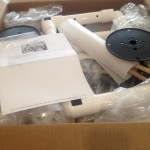 But there are a couple of things that I didn't quite understand. If anyone out there in fiber-land knows what these are please let me know. First there are two holes on each side of the base that don't seem to have a definite purpose. They might be there to fix the diagonal uprights, but there was nothing about them in the instructions so I have no way of knowing. Second, the horizontal support for the bobbin/flyer assembly doesn't quite sit flush on the diagonal uprights. I've seen some folks online who put some padding in between, and that's a okay fix I guess. There was also nothing in the instructions about fixing the diagonal uprights to the base. This maybe a conscious decision so that it's easier to take apart for travel, but the holes on the base and the extra space at the top of seems to suggest that there is something missing from the assembly instructions relating to these parts. More on this in a bit.
But there are a couple of things that I didn't quite understand. If anyone out there in fiber-land knows what these are please let me know. First there are two holes on each side of the base that don't seem to have a definite purpose. They might be there to fix the diagonal uprights, but there was nothing about them in the instructions so I have no way of knowing. Second, the horizontal support for the bobbin/flyer assembly doesn't quite sit flush on the diagonal uprights. I've seen some folks online who put some padding in between, and that's a okay fix I guess. There was also nothing in the instructions about fixing the diagonal uprights to the base. This maybe a conscious decision so that it's easier to take apart for travel, but the holes on the base and the extra space at the top of seems to suggest that there is something missing from the assembly instructions relating to these parts. More on this in a bit.
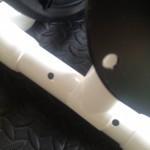
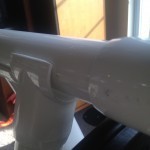 With these questions aside though, it was pretty easy to put together and it works pretty well. Some people have criticized the Babe wheels for not being very pretty and made of PVC instead of wood, but I actually kind of like the way it looks, and that's maybe because I'm seeing what I can make with it instead of seeing the object itself. I also know that a lot of folks, as mentioned in the video will paint or otherwise decorate their Babes and that sounds like fun.
With these questions aside though, it was pretty easy to put together and it works pretty well. Some people have criticized the Babe wheels for not being very pretty and made of PVC instead of wood, but I actually kind of like the way it looks, and that's maybe because I'm seeing what I can make with it instead of seeing the object itself. I also know that a lot of folks, as mentioned in the video will paint or otherwise decorate their Babes and that sounds like fun.
I've been using it for a couple of weeks now and have spun yarn from sock weight to bulky. I've also done some core spun and some beaded yarn. Here's a break down of my feelings on it.
Things I love:
The large orifice (get your minds out of the gutter, it's a technical term): This wheel has a 3/4 inch orifice which makes spinning art yarns a dream. It's perfect for add-ins like beads and bits of fabric or little flowers. The only thing better would be a bypass-able orifice, but I'm not a fan of art yarn add-ins that are super huge, so I don't miss that.
The treadling: I was a little concerned switching from a single treadle wheel to a double treadle wheel, but this is so easy to treadle, and easily adjustable. the treadles attach to the base with velcro straps that can be adjusted if they are set too tight.
The enormous bobbin: I have yet to run out of space on these bobbins no matter how thick my yarn.
It travels: The shape, easy assembly and light material mean that it travels well so when I take the kids down for a week at Granny's or to spin with friends, it can go with me without too much trouble. A Saxony style wheel like my traditional is a pain to move.
The little velcro leader grabber: Not sure what the proper name is but each bobbin has a little velcro circle on it that you can easily use to attach your leader without having to tie a knot or anything. It's a small feature, but really good thinking on their part.
The velcro patch by the orifice: Another little bit of velcro sits right below the orifice to hold your yarn if you have to stop while you're spinning. As a mom it's rare that I get to sit down and spin a hank without stopping, so this comes in very handy.
The green-ness of it all: Very few of the parts for this wheel are specifically manufactured for a spinning wheel. with the exception of wooden flyer and the treadle assembly, everything else is re-purposed. The body is PVC, the wheel is a wheelchair wheel, the bobbins are wire spools. I love the idea that there are very few trees being cut down or factories with specialized equipment being run to create this. Most of these things are being made anyway. This is also how Babe's Fiber Garden can keep the cost of their wheels so much lower than most wheel makers.
Things I hate:
The lazy Kate: The lazy kate for this wheel consists of two dowels inserted into holes on the diagonal uprights.
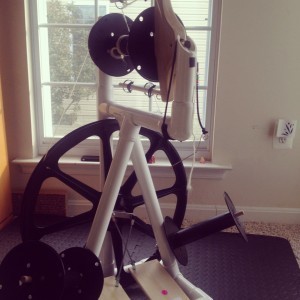 They don't turn very easily because of the larger heavier bobbins. This makes for difficult plying and lots of broken singles. I love the sort of zen feeling I get plying on my Ashford with the yarn just sliding through my fingers and twisting, not so with the Babe.
They don't turn very easily because of the larger heavier bobbins. This makes for difficult plying and lots of broken singles. I love the sort of zen feeling I get plying on my Ashford with the yarn just sliding through my fingers and twisting, not so with the Babe.The peg that connects the bobbin to the whorl: Most of Babe's wheels seem to be bobbin led as opposed to the flyer led Ashford. This means that the whorl being turned by the drive band connects directly to the bobbin instead of to the flyer. The Babe wheel uses a wooden peg sticking out from the plastic whorl to fit into a hole in near the center of the bobbin. This is fine as long as it stays connected, but I have found that as your bobbin gets more full it tends to pull away and the whorl and bobbin can become disconnected leaving you treadling away to no effect. Also the peg is glued into a hole on the whorl, and after a couple of weeks of use, mine came unglued and the peg came out altogether. It's easy enough to fix by putting the peg back in and re-gluing it with some epoxy, but it's something that I don't think a couple of weeks of use (and that's not every day) should cause to happen. If this is a "production" whee, then it ought to be able to stand up to more use than that.
The diagonal cut on the flyer support: The orifice at the end of the flyer rests in a slot on the front piece of PVC which is cut at a diagonal. This is fine, but if you get a little too relaxed with where your hand is you can find your yarn rubbing up against this cut and it's sharp enough that if your yarn is thin it might actually cut some fibers. This can be fixed by sanding, but again should I have to be the one doing that?
The unattached diagonal uprights: As I mentioned before the diagonal upright supports on this wheel don't attach to the base or the flyer support, at least there wasn't anything in the instructions about attaching them. The result is, the support rests on the uprights and they rest on the base. I have found though, that after a lot of treadling and vibration these uprights can move and make even fall out of place or move too close to the wheel and rub the drive wheel. I really wish the instructions had some explanation of how these are supposed to be fixed or tips on how to keep them in place.
I said I didn't want to call this a review because I haven't passed judgement on the wheel. There are things I love and things I hate. Most of the things I hate are fixable, and I'm a DIY kinda gal, so they're not big deals. But I did notice when I was researching which wheel to buy that there weren't a lot of informative reviews. So, here's the information that I would have liked to have known. I still think I would have bought this wheel over the Ashford Country, but I hope I can offer some info for folks like me that want to make a more informed decision.
January 31, 2012
To outline or not to outline
I can't count the number of writers that I've heard in various forums saying that they just sit down and write and "let the story take me where it will" or something like that. These people often say that they don't know how a story will end when they start writing. Now, I'm not one to cast aspersions on anyone's process. I say do what works for you, as long as it's actually WORKING. I however, have never been one to just sit and write with no end in mind, at least not for anything longer than a blog post. That method might work for poetry, flash fiction or even short stories, but anything longer than a few printed pages and I better have an outline.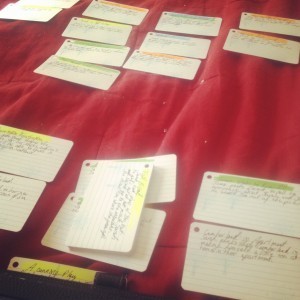
This could be the fault of my high school English teacher, Rita Mullins. Aside from Mrs. Mullins many gems of literary wisdom, one of the things that she taught us that I have used the most, is how to create and work from an outline. I don't want to brag (Yes, I do.) but as a corporate trainer, I never missed a deadline for writing training material. That was entirely due to this habit of working from an outline. Where other trainers who weren't natural writers would sit and stare at blank screens trying to come up with a plan, I would schedule a plan allowing a specific amount of time for researching, brainstorming, outlining, writing and editing and I would work that plan. Voila! Training class on time with minimal stress.
Here are some of the key things that an outline provides for me:
1) Direction: Novel writing isn't a simple as writing training manuals. Sometimes I just feel a scene and it's better to write that when I'm feeling it or it might lose its emotional punch. But if I don't want to lose my way writing from point A to point Z then an outline is a necessity. There is always room for switching items around, changing order and scrapping scenes altogether. That's why I tend to do my outline on index cards, and nerdily color code them according to plot or sub-plot. For a large project like a novel, it's a way to get a bird's eye view of the whole story. Plus it's reminder of what needs to be written next. That doesn't mean that I write scenes in order. If I'm feeling one scene I might work on that. Likewise, if I'm not feeling one, then I can check what else needs to be written and try one of those.
2) Plot Check: Working without an outline is a bit like driving on back country roads with no map or GPS. It might be a lot of fun, in fact that's one of my favorite pastimes, but unless I have some set destination in mind, I'm likely to meander about with no direction take forever to get where I'm going. A book is not like that. If you meander about too much you risk losing the reader's interest. Lengthy passages about the beauty of barns on the back roads of central Virginia might be fun for me to write, but they're not going to turn pages. Every scene should move the plot forward, and using an outline helps me make sure of that. I can ask myself if an item in my outline moves the plot forward and if it doesn't, I can chuck it. Likewise, I can ask myself if anything is missing. Do the events in my outline motivate my characters to do what they are supposed to do? If not, what else do I need?
3)Accomplishment: There's a reason why I don't knit blankets or sweaters. It's not that I don't like them, I just don't like big projects like that. I get impatient and want to move on to the next thing. I actually get a little depressed if I don't have that sense of accomplishment that  comes with finishing something every now and then. So, a big writing project like a novel or (gasp!) a series of novels can be a daunting task. Working from an outline helps me break that down to smaller more manageable tasks. I go act by act, scene by scene and check them off as I finish drafting each one. I even go so far as to print them out and put them into a notebook in the order of my outline right behind the relevant index card or cards for that scene. This way I can look at the manuscript and feel like I'm moving forward.
comes with finishing something every now and then. So, a big writing project like a novel or (gasp!) a series of novels can be a daunting task. Working from an outline helps me break that down to smaller more manageable tasks. I go act by act, scene by scene and check them off as I finish drafting each one. I even go so far as to print them out and put them into a notebook in the order of my outline right behind the relevant index card or cards for that scene. This way I can look at the manuscript and feel like I'm moving forward.
As I said before, I'm not disparaging anyone's process or lack thereof. I'm just saying that the old adage "Fail to plan, plan to fail" is famous for a reason. It takes a remarkably rare talent to just sit down and write a book without knowing the direction or having the end in mind. So if you're a writer, you might ask yourself. Am I that rare creative genius that can do that, or am I a classically trained samurai?
January 27, 2012
Don't Fear the Rewrite
About ten years ago (yes really, that long ago) I got the idea for the novel that I'm currently working on. It came in the form of a prologue. I know prologues are out of vogue, but I've checked and rechecked my reasons for having one, and I'm definitely sure it's the way to go. I wrote the prologue and was pretty happy with it. In the intervening years, I have outlined and written about half the book, other short stories, researched, had a career in corporate training, had two children, bought a house, sold a house, and generally lived a life. All of those things have contributed to my maturing as a writer.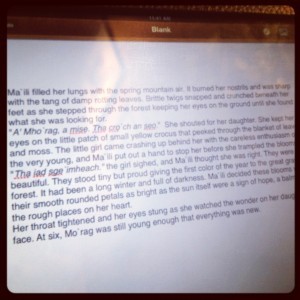
So, last year when I picked the novel up again after a hiatus, I read the prologue and was thoroughly unhappy. It meandered through the heads of the characters involved without direction. The descriptions were overblown and some of the dialog was down right syrupy. In the years since I wrote the original prologue, the characters have become clearer in my mind. I have even outlined a whole series of books with these characters. Two of them in particular aren't alive, during the main story line, so the prologue is the first of just a few places that the reader will be able to get their perspectives. The prologue should focus on them, and its original edition did not.
My years of writing training materials as a corporate trainer have conditioned me to write to an outline. It also got me used to working to a deadline, which I always managed to by keeping to an "always moving forward" way of working. If I get stuck on something, I move to something else until my mental block clears itself, or I find the information I need to finish. That's also why I always have multiple projects going. I'm always moving forward on one of them. So with that in mind, I was loath to spend valuable time going back and completely rewriting something that I had checked off my novel writing to do list. I told myself that I just had to get the rest out before I could go back and rewrite the prologue.
The trouble is, I floundered somewhere around chapter 9. As I was writing the rest of the story, the characters and events included in the prologue solidified in my mind more and more. I seemed to lose my way with the rest of the plot. I couldn't stop thinking about that prologue and how important is was to tell that story well before I could get the rest of it right. I finally had to bite the bullet and rewrite the darned thing. That's just what I've spent my few hours of true writing time for the last week or so doing, and I couldn't be more pleased.
What was unfocused and immature, is now true to the characters whose stories need to be told there. It has depth and subtext and foreshadowing that suggests where the overall series in addition to that novel will go. It doesn't reveal too much, but gives the right amount of characterization and a tantalizing glimpse of the heroine's back story. And best of all the writing doesn't make me want to hurl my iPad across the room as the original version did. It also has the added benefit of making me feel so much more focused about moving forward. I know some things in my outline need to be changed, what needs to be added and taken out. Rewriting took extra time that I could used to advance the plot, but it's also helped me refocus. Now, when I advance the plot I know I'll be moving in the right direction.
January 23, 2012
Cashmere, cashmere, cashmere
First let me start by saying that my parents are awesome for a million different reasons that I don't have space for in a blog post. But this Christmas one of the forms that said awesomeness took had to do with fiber. The Woolery, an excellent purveyor of all things fibery has a wishlist feature. So, when my mom asked what I wanted for Christmas, I pointed her to my wishlist at The Woolery. She wasn't able to find my wishlist, so she called them and put her gift budget in their very capable hands. What resulted was box of fiber that represented a sampler of almost everything they have to offer. There are several kinds of wool including Merino, alpaca, llama, angora, mohair, camel and cashmere. So, you will likely be seeing a posts about all of these fibers and what I'm choosing to do with them, but I thought I would start with cashmere. [image error]
It's a good thing that I got this as a gift, because at $20-$22/oz it's unlikely that I would have bought this fiber for myself (I'm cheap, remember.) I'm sooo glad though that I had the experience and if you're going to shell out that kind of dough [image error]for fiber, I can highly recommend the cashmere from The Woolery. It was a very high quality. You know when you go into a department store and see a sign for cashmere sweaters at some ridiculously low price and then you touch it and realize that the price isn't so ridiculous after all. This is not that cashmere. This stuff feels like heaven. It's so smooth and fine.
Since this was my first experience spinning cashmere, I decided not to blend it with anything, but to spin it by itself to get a feel for it. The carded roving drafts easily. Because the fibers are short, I recommend not treadling too fast or you'll lose your leader. But this fiber feels so good, you won't want to spin too fast, because 2 oz goes by quickly.
Cashmere varies in color from white to dark brown or medium gray. On their listing at The Woolery, they say the color is light brown although their picture looks sort of dishwater blonde. Thank goodness it's not that color. Honestly, seeing that picture next to that price would normally have turned me off, but mine was actually a very nice light woodsy brown with just a little bit of a sheen to it once it's spun.
I made about 140 yards of 2-ply sport weight yarn. I was pleasantly surprised at how much my yarn I got from my 2 oz of fiber. When I fulled it the twist seemed to tighten a little and the result is a very springy yarn.
Now I just need to figure out what I'm going to do with it. I could put the yarn in the shop to sell. Then again, it feels so good I might want to make a scarf just to keep my hands on it.
January 19, 2012
I have a confession to make
And I hope you won't take this the wrong way. I'm only half listening to you.
[image error]It's not that I don't care about you, in fact I probably care more than the next person. But the fact is that while you're talking to me about; the weather, your job or your toddler's propensity for sorting his toy cars according to color, in my head is a whole other world. There a broad cast of characters is falling in love, catching a serial killer, or searching for the Holy Grail. They have lives and loves and histories that rival any of ours. This goes far beyond mere daydreaming. So if I seem a bit distant or respond in an awkward way, it's only because I'm caught up in the epic struggles going on in my head.
It's been this way for as long as I can remember. My parents will tell you stories of the whole worlds that I would make up as a child before I ever learned to read and write. I could shut myself in my room for ages and live out sagas of my own making. I was and still am perfectly happy being alone. In fact, sometimes I crave it.
My AP History teacher in high school, upon hearing another teacher complain about me not paying attention in class was heard to say, "Well, Meredith has her own agenda." Mr. Ridgeway got it. He knew that even though I was sitting in his class and part of my brain was listening another part was in another world. He could handle the fact that on my desk was one notebook for taking notes and another for writing. Fortunately, I have run into a few people in my life who do get it. I treasure those people and occasionally give them my full attention. The part that was in class, incidentally kicked ass on the AP exam and got college credit for American History. Likewise the part of me that was present in my college classes made the Dean's List. Still, there is always that part of me that is in a cabin in the mountains, on a ship crossing the ocean, in Scotland/Mexico/Peru.
So, it's not that I don't like you or that I'm not listening, it's just that the people in my head are talking too, and sometimes they drown you out.
January 10, 2012
Do you write for yourself, or for readers?
There are people who write for themselves.
These people write what they want, the way they want it and if you don't like it than that's just your opinion. Their work is often riddled with incorrect diction, punctuation and bad grammar. When anyone points those things out to them, they meant it to be that way to serve the story.
You've probably seen the singing equivalent of these people on American Idol. They're the ones that come into their auditions full of confidence because their parents/friends/church family have all told them that their singing is nice (usually because they don't want to hurt their feelings with the truth). When they are told the truth about their singing, they rationalize it by saying "That's YOUR opinion!" Naturally, we're talking about the opinions of experienced music industry professionals who have a pretty solid basis for comparison. Still, the contestant will walk away from the encounter confident in their belief that what they do is awesome even if the judges didn't like it. In my house we call these people, "Classically Trained Samurai" because there is now way in this century to become a "Classically Trained Samurai" (Look it up), yet there are people who insist that they are just that. Given that the samurai class in Japan was abolished in the late nineteenth century, these folks are Samurai in their own minds. They fight and/or practice for themselves just as some writers write for themselves. And often publish for themselves hoping that they will find other "Classically Trained Samurai" who are interested in the same kind of things that they are and will enjoy their work.
Then there are people who write for readers.
These are writers who very often make a ton of money, and write in whatever genre is popular at a given time. James Patterson is a perfect example of this. Wildly successful as a mystery writer, he then branched out into pretty much whatever genre/subgenre is trending; Wizards, Awkward Adolescent, Women's Fiction. Patterson at least credits his co-authors since no one person could possibly write this much fiction fast enough to take advantage of current trends. While I might initially be prone to sneer at this sort of genre chasing (not that crossing genres is bad, I write/read more than one genre too), Patterson is I'm sure making money hand over fist. There is also something to be said for pleasing the crowd, which he usually does.
I however, think that some of the best writing falls somewhere in between these two poles. We all choose what to write about based on our windows on the world. I for example and a history loving Southern girl who is also a Scotia-phile. So, I like to write about my roots in North Carolina and the history there and about Scots. The Once & Future Series that I'm working on is something that I'm writing for myself because these characters have been living in my head for years, and I would like for them to live on pages or screens for others to enjoy. But I'm also conscious of the fact that in order for others to enjoy the story, I have to be interested in their opinions. I need feedback from readers about the narrative and the style. Is it engaging? Is it easy to understand? Are the characters believable?
Every writer needs this kind of feedback and should seek it out, preferably prior to publishing. However, if you're true to your vision you'll take this feedback with a grain of salt. We writers have to pick and choose what changes to make. Keeping that choice in the hands of the writer is one of the great things about indie publishing. I can incorporate feedback that says "this needs more action and less Celtic myth nerd-dom". I can also say no to morphing my characters into teenage malcontent vampires at wizard school because someone says that YA Paranormal Romance is super hot these days. It's a balancing act that is essential if you mean to publish and actually sell books even if not as successfully as James Patterson.
With that said, I'll soon be sending out my latest piece of historical fiction to my beta readers to get that feedback prior to publishing. Since it's based on a true story, hopefully no one will ask me to change the ending.
December 19, 2011
Please, indie authors…
Feel free to imagine me giving you the stink-eye over the top of my Miss Crabtree spectacles when I say this. We've got to do a better job of proofreading books.
I know it's hard, and I'll admit that the first edition of The White House despite my best efforts was published with a handful of errors that have since been corrected. I just have to get this off my chest. Because I love indie books and what indie publishing is doing to the industry, I feel like this must be said.
If we want to be taken seriously as authors/publishers, our stuff has to be as close to perfect as we can make it. I hear on many reader discussions and boards that people don't like to read indie books because of grammatical and formatting errors. Naturally this is followed by a comment left my some well meaning indie author who says some thing like, "Well, traditional publishers miss typos and errors too." And that's sadly true. But is the lowest common denominator really the measuring stick that you want to use?
My 7 year old son with ADHD frequently follows tales of how he got called out by the teacher for some infraction by telling me of the troubles of another student in his class with worse behavior issues. My response to this is to point out the worst behaved kid in the class should not be setting the standard for good behavior. "Well, they're just as bad." or "They did it worse." are not the statements of people seeking excellence. If we as independents want our books to be considered on par with traditionally published books, we cannot stop at good enough.
With that said, I'd like to point out some common mistakes that I have seen in many of the indie books that I have read lately. None of these would be caught by a spelling or grammar check.
Mixed Up Homophones – Anyone who has talked to anyone on the internet is familiar with people mixing your and you're or there, their and they're and I'll admit I have to hold onto my desk to keep from correcting people constantly. But more disturbing lately are mix ups like past and passed. For the record passed is a verb. Past is an adjective and sometimes a noun. Too often lately, I have seen sentences like this, "The people on the street walked right passed the victim bleeding onto the sidewalk." That would be the wrong usage for the verb, passed. Here is a correct example, "I burned my fingers on the hot dish when Aunt Martha passed me the peas." This is just one of the examples of surprisingly mixed up homophones that I have seen in indie books of late.
The Extra Word – This is an error that seems to occur a lot when the word flow from brain to fingers gets muddled, or when a writer goes back to make a change to a sentence, but doesn't completely delete the original words. Here's an example. "He heard the shallow wheeze of her breath and some small part of him tried to believe how that she would make it back to port." It's easy to see how this can happen, but is very jarring to the reader's ear. This can take a reader right out of your story and destroy the flow of your prose.
Spell-check Escapees – These are misspellings that are actually words and therefore not caught by spell-check. Naturally these words just come off as wrong and the story teller loses credibility. For example: "He'd never been so chose to death before." Chose is a word and would not be detected by a spell checker, but it doesn't make sense in the context of the sentence. The actual sentence should read. "He'd never been so close to death before." which makes for an evocative sentence. The meaning and emotional punch of the sentence is completely lost with the incorrect word there. Spell-check is clearly not a reliable proofreader.
Now, I'm sure you're probably cursing me for a self-righteous busybody at the moment, but have patience. I have some suggestions.
Indies that we are, most of us (me included) don't have big budgets with which to hire editors. I'm currently publishing short stories while working on a novel, so I'm not going to shell out the cash for an editor for projects that small. However, there are a few tricks we can use to make those little errors standout for correction before you publish.
Read It Out Loud – I'm sure you've probably heard this suggestion regarding the flow of your prose. If you've tried it for that purpose, I'm betting that while you were reading you came across some errors. Reading your manuscript out loud is one of the greatest tools a writer has. It can call attention to awkward phrasing, clunky dialog (more on that in another post), typos, and grammatical errors. I really can't say enough good things about it.
Print It Out- Often a change of scene helps to call attention to things that we might not have noticed. It is hard sometimes to see these errors on our computer/laptop/iPad screens when we're typing or rereading what we've written. Printing it out calls more attention to some of those errors. I try to be a pretty green-living girl and I know toner is expensive, but this really is a great way to review your manuscript for errors. They just seem to pop out more on paper than they do on the screen. If you print it out and then read out loud from the printed manuscript you can kill two birds with one stone.
Other Eyes – No matter how many times you go back and read your manuscript the reality is, those words came from your head. Because of that you are predisposed to mentally fill in any gaps that might occur. You might not be the best person to proofread your manuscript. The reader can't read your mind, so the words on the page/screen have to be clear. Chances are if you're writing a book, you probably have some friends who like to read. Get one or two or five of them to take a look at your manuscript. They will most likely pick out some things that you missed.
In my previous life as a corporate trainer, I saw quite a few resumes. It may sound cruel especially in this job market, but when faced with a stack of resumes, I would first filter out the ones with grammatical errors. My thinking was that if someone is putting this document out there to speak for them and they didn't take the time to proofread it, then they don't have the attention to detail that's required for the job (or frankly any job). I don't see our books as any different. They may not create the reader's first impression of you, but they will create a lasting impression. So, indie writers, what is the impression that you want to make?
In closing, I would like to return to the issue of homophones. Rather than prattle on about how annoying I find this, I'll leave it to Brian McKnight and a puppet.



